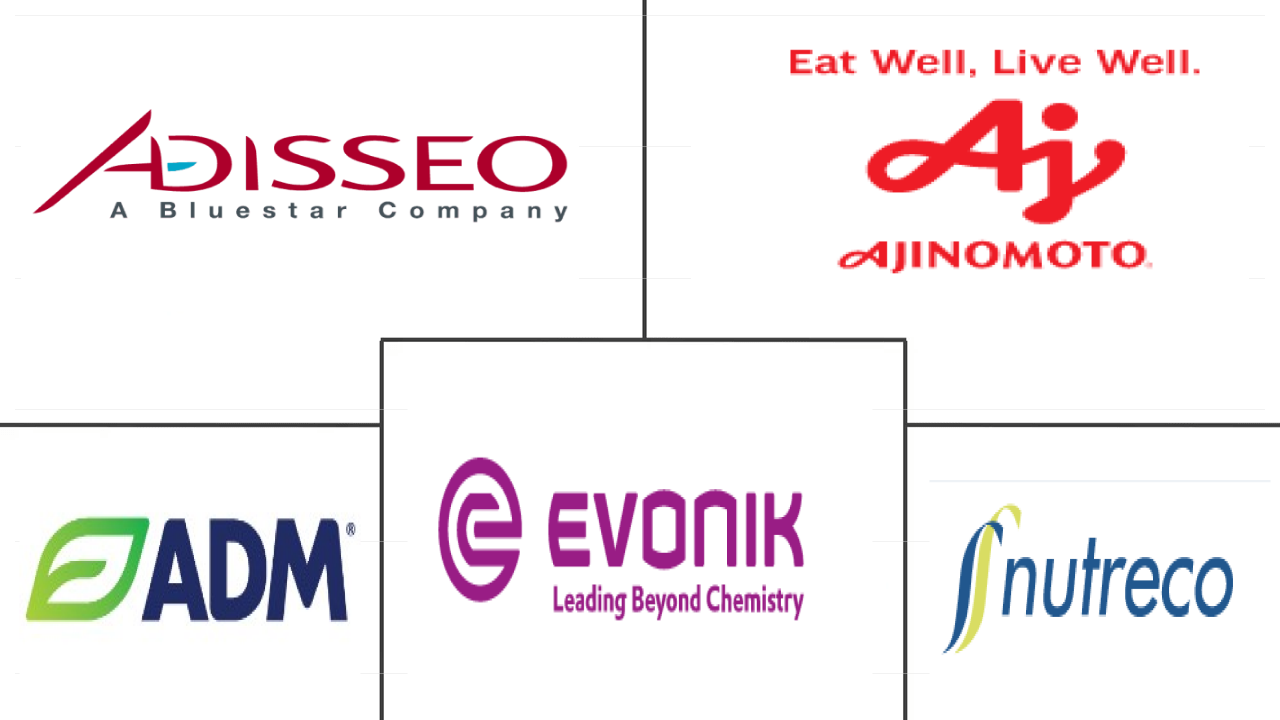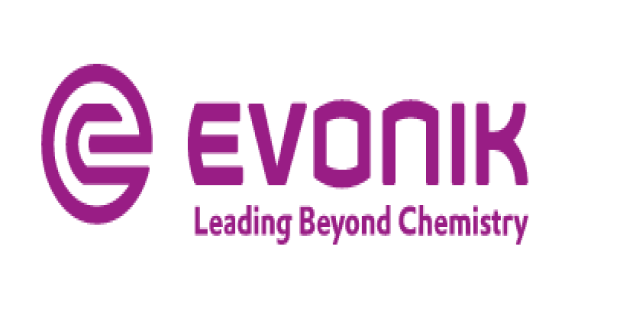Market Size of asia-pacific feed amino acids Industry
| Icons | Lable | Value |
|---|---|---|
|
|
Study Period | 2017 - 2029 |
|
|
Market Size (2024) | USD 2.43 Billion |
|
|
Market Size (2029) | USD 3.11 Billion |
|
|
Largest Share by Sub Additive | Lysine |
|
|
CAGR (2024 - 2029) | 5.07 % |
|
|
Largest Share by Country | China |
|
|
Market Concentration | Low |
Major Players |
||

|
||
|
*Disclaimer: Major Players sorted in no particular order |
APAC Feed Amino Acids Market Analysis
The Asia-Pacific Feed Amino Acids Market size is estimated at 2.43 billion USD in 2024, and is expected to reach 3.11 billion USD by 2029, growing at a CAGR of 5.07% during the forecast period (2024-2029).
2.43 Billion
Market Size in 2024 (USD)
3.11 Billion
Market Size in 2029 (USD)
8.05 %
CAGR (2017-2023)
5.07 %
CAGR (2024-2029)
Largest Market by Sub-Additive
32.95 %
value share, Lysine, 2023
Lysine demand is highest in the region due to its importance in the growth of animals, being a major amino acid in ideal protein feed, and an increase in feed production.
Largest Market by Country
32.80 %
value share, China, 2023
China is the largest market because of the increase in the livestock population and the rapid expansion of meat, pork, and egg production.
Fastest-growing Market by Sub-Additive
5.36 %
Projected CAGR, Methionine, 2024-2029
Methionine is the fastest-growing segment due to its increased efficiency characteristics, such as regulating metabolic processes, the innate immune system, and improved gut health.
Fastest-growing Market by Country
6.10 %
Projected CAGR, Thailand, 2024-2029
Thailand is the fastest-growing market due to rising meat and other end-product consumption and growth in the livestock population.
Leading Market Player
11.31 %
market share, Evonik Industries AG, 2022

Evonik Industries AG is the market leader as it focuses on partnerships with regional players for market penetration and has one of the largest production plants in Singapore.
- Asia-Pacific holds a significant share of the global feed additives market, with amino acids accounting for 21.4% of the total market value in 2022. Lysine and methionine are the most important amino acids required for animal growth and maintenance. In 2022, these two amino acids together accounted for 65.5% of the feed amino acids market in terms of value in the region.
- Poultry is the largest animal type in the Asia-Pacific feed amino acid market, accounting for 46.8% of the total market value in 2022, mainly attributed to the 6.6% increase in poultry headcount between 2017 and 2022. The market is projected to record a CAGR of 5.8% during the forecast period.
- China is the largest country in Asia-Pacific with respect to the feed amino acids market, holding a market share of 32.7%, by value, in 2022. This high share was associated with the country's higher feed production, which reached 243.2 million metric tons in 2022, marking a 20.1% increase from 2017 to 2022.
- Methionine is the fastest-growing segment in the Asia-Pacific feed amino acids market, and it is expected to record an annual growth rate of 5.3% during the forecast period. Its importance in protein synthesis and animal growth is the primary reason for the high growth rate. In 2022, the market value of methionine was USD 716.6 million due to its efficiency characteristics, such as regulating metabolic processes, improving gut health, and easy digestion in animals.
- Overall, the importance of amino acids in animal nutrition and the growing animal feed production in the region are the factors expected to drive the growth of the Asia-Pacific feed amino acids market, with a CAGR of 5.0% during the forecast period.
- Asia-Pacific is one of the most important regions with respect to the feed amino acids market. China, India, and Japan are the major countries that dominate the market. In 2022, these countries accounted for almost half of the total market value of feed amino acids in the region. China is the region's largest consumer of feed amino acids, valued at USD 722.8 million in 2022, which is expected to reach USD 1,034.5 million in 2029, registering a CAGR of 5.3%. The high usage of feed amino acids in China is mainly due to the presence of a large livestock population. In 2022, China accounted for 78% of the total swine population in the region.
- Australia's total feed production increased from 7.5 million metric tons to 8.0 million metric tons between 2017 and 2022. Poultry feed was the most widely produced feed, accounting for 3.2 million metric tons in 2022, which was a 35.4% increase from 2017. The increase in feed production is expected to lead to a rise in the demand for feed amino acids in the country during the forecast period.
- Thailand and Indonesia are the fastest-growing countries with respect to the feed amino acids market in the Asia-Pacific region. Both countries are expected to witness a CAGR of 6.1% during the forecast period due to the increased livestock population. The poultry population in Thailand and Indonesia increased by 7.4% and 7.7%, respectively, between 2017 and 2022.
- The total feed production in the Asia-Pacific region increased by 30.3% from 2017 to 2022. With the rise in feed production and the increase in the animal population, the market for feed amino acids in the region is expected to register a CAGR of 5.0% during the forecast period.
Asia-Pacific Feed Amino Acids Industry Segmentation APAC Feed Amino Acids Industry Segmentation
Lysine, Methionine, Threonine, Tryptophan are covered as segments by Sub Additive. Aquaculture, Poultry, Ruminants, Swine are covered as segments by Animal. Australia, China, India, Indonesia, Japan, Philippines, South Korea, Thailand, Vietnam are covered as segments by Country.
- Asia-Pacific holds a significant share of the global feed additives market, with amino acids accounting for 21.4% of the total market value in 2022. Lysine and methionine are the most important amino acids required for animal growth and maintenance. In 2022, these two amino acids together accounted for 65.5% of the feed amino acids market in terms of value in the region.
- Poultry is the largest animal type in the Asia-Pacific feed amino acid market, accounting for 46.8% of the total market value in 2022, mainly attributed to the 6.6% increase in poultry headcount between 2017 and 2022. The market is projected to record a CAGR of 5.8% during the forecast period.
- China is the largest country in Asia-Pacific with respect to the feed amino acids market, holding a market share of 32.7%, by value, in 2022. This high share was associated with the country's higher feed production, which reached 243.2 million metric tons in 2022, marking a 20.1% increase from 2017 to 2022.
- Methionine is the fastest-growing segment in the Asia-Pacific feed amino acids market, and it is expected to record an annual growth rate of 5.3% during the forecast period. Its importance in protein synthesis and animal growth is the primary reason for the high growth rate. In 2022, the market value of methionine was USD 716.6 million due to its efficiency characteristics, such as regulating metabolic processes, improving gut health, and easy digestion in animals.
- Overall, the importance of amino acids in animal nutrition and the growing animal feed production in the region are the factors expected to drive the growth of the Asia-Pacific feed amino acids market, with a CAGR of 5.0% during the forecast period.
| Sub Additive | |
| Lysine | |
| Methionine | |
| Threonine | |
| Tryptophan | |
| Other Amino Acids |
| Animal | |||||||
| |||||||
| |||||||
| |||||||
| Swine | |||||||
| Other Animals |
| Country | |
| Australia | |
| China | |
| India | |
| Indonesia | |
| Japan | |
| Philippines | |
| South Korea | |
| Thailand | |
| Vietnam | |
| Rest of Asia-Pacific |
Asia-Pacific Feed Amino Acids Market Size Summary
The Asia-Pacific feed amino acids market is a significant segment within the global feed additives industry, with amino acids playing a crucial role in animal nutrition. The region is characterized by a robust demand for essential amino acids like lysine and methionine, which are vital for animal growth and maintenance. Poultry emerges as the dominant animal type in this market, driven by an increase in poultry headcount and production. China stands out as the largest market within the region, supported by its substantial feed production and large livestock population. The market is witnessing a steady growth trajectory, fueled by the rising demand for animal feed and the expanding livestock and poultry industries across countries like China, India, and Japan.
The market landscape is marked by the presence of major players such as Adisseo, Ajinomoto Co., Inc., Archer Daniel Midland Co., Evonik Industries AG, and SHV (Nutreco NV), who collectively hold a significant share of the market. The region's feed amino acids market is also experiencing growth in the aquaculture sector, with countries like China leading in aquafeed production due to increased aquaculture activities and technological advancements. The demand for feed amino acids is expected to rise further, driven by the expansion of poultry and aquaculture production, as well as the implementation of government initiatives to boost sustainable seafood production. Overall, the Asia-Pacific feed amino acids market is poised for continued expansion, supported by the growing agricultural sector and increasing consumption of animal protein.
Asia-Pacific Feed Amino Acids Market Size - Table of Contents
-
1. MARKET SEGMENTATION (includes market size in Value in USD and Volume, Forecasts up to 2029 and analysis of growth prospects)
-
1.1 Sub Additive
-
1.1.1 Lysine
-
1.1.2 Methionine
-
1.1.3 Threonine
-
1.1.4 Tryptophan
-
1.1.5 Other Amino Acids
-
-
1.2 Animal
-
1.2.1 Aquaculture
-
1.2.1.1 By Sub Animal
-
1.2.1.1.1 Fish
-
1.2.1.1.2 Shrimp
-
1.2.1.1.3 Other Aquaculture Species
-
-
-
1.2.2 Poultry
-
1.2.2.1 By Sub Animal
-
1.2.2.1.1 Broiler
-
1.2.2.1.2 Layer
-
1.2.2.1.3 Other Poultry Birds
-
-
-
1.2.3 Ruminants
-
1.2.3.1 By Sub Animal
-
1.2.3.1.1 Beef Cattle
-
1.2.3.1.2 Dairy Cattle
-
1.2.3.1.3 Other Ruminants
-
-
-
1.2.4 Swine
-
1.2.5 Other Animals
-
-
1.3 Country
-
1.3.1 Australia
-
1.3.2 China
-
1.3.3 India
-
1.3.4 Indonesia
-
1.3.5 Japan
-
1.3.6 Philippines
-
1.3.7 South Korea
-
1.3.8 Thailand
-
1.3.9 Vietnam
-
1.3.10 Rest of Asia-Pacific
-
-
Asia-Pacific Feed Amino Acids Market Size FAQs
How big is the Asia-Pacific Feed Amino Acids Market?
The Asia-Pacific Feed Amino Acids Market size is expected to reach USD 2.43 billion in 2024 and grow at a CAGR of 5.07% to reach USD 3.11 billion by 2029.
What is the current Asia-Pacific Feed Amino Acids Market size?
In 2024, the Asia-Pacific Feed Amino Acids Market size is expected to reach USD 2.43 billion.

